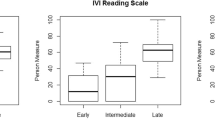Abstract
Given the enormous recent interest in functional capabilities related to vision, the goal of this study was to examine the relationship of standard clinicial measures of vision (e.g. Snellen acuity) to functioning and well-being. The association between Snellen visual acuity, Amsler grid distortion and presence of diabetic retinopathy with self-reported functioning and well-being (SF-36) were examined in a sample of 327 diabetics from the Medical Outcomes Study (MOS). There was little or no correlation between Snellen visual acuity, Amsler grid distortion or diabetic retinopathy and functioning and well-being (i.e. SF-36 scales). Maximum product-moment correlation was 0.15 with worst eye visual aculty, 0.13 with best eye visual acuity, 0.08 with presence of retinopathy, and 0.10 with Amsler grid distortion. Analysis of variance revealed that visual acuity (both best and worst eye) was statistically related only to the physical function scale; no other exam measure was related to any other SF-36 scale score. Snellen visual acuity, Amsler distortion and diabetic retinopathy correlate weakly with patient self-reported functioning and well-being. Thus, the information provided by functioning and well-being measures is complementary to that of standard clinical measures of visual ability.
Similar content being viewed by others
References
Agency for Health Care Policy and Research.Cataract in Adults: Management of Functional Impairment. AHCPR Publications, 1993. [No. 93-0542, March]
Mangione CM, Phillips RS, Lawrence MG, et al. Improved visual function and attenuation of age-related declines in health-related quality of life after cataract extraction.Arch Ophthalmol 1994;112: 1419–1425.
Applegate W, Miller ST, Elam JT, et al. Impact of cataract surgery with lens implantation on vision and physical function in elderly patients.JAMA 1987;256: 1064–1065.
Steinberg EP, Tielsch J, Schein OD, et al. The VF-14: an index of functional impairment in patients with cataract.Arch Ophthalmol 1994;112: 630–638.
American Academy of Ophthalmology.Cataract in the Otherwise Healthy Adult Eye. San Francisco: American Academy of Ophthalmology, 1989.
Tarlov AR, Ware JE, Greenfield S, et al. The Medical Outcomes Study: an application of methods for monitoring the results of medical care.JAMA 1989;262: 925–930.
Schuchard RA. Validity and interpretation of Amsler Grid reports.Arch Ophthalmol 1993;111 776–780.
Hays RD, Sherbourne CD, Mazel RM. The RAND 36-Item Health Survey 1.0.Health Ecom 1993;2: 217–227.
Ware JE, Sherbourne CD. The MOS 36-Item health survey (SF-36): I. Conceptional framework and item selection.Med Care 1992;30: 473–483.
McHorney CA, Ware JE, Raczek AE: The MOS 36-item short-form health survey (SF-36): II. Psychometric and clinical tests of validating in measuring physical and mental health constructs.Med Care 1991;31: 247–263.
Lee P, Hays R, Spritzer K. The functional impact of blurred vision on health status.Invest Ophth Vis Sci 1993:34 (Suppl): 790.
Fryback DG, Dasbach EJ, Klein R, et al. Vision-related health status: The Beaver Dam Health Outcomes Study.Invest Ophth Vis Sci 1992;33 (Suppl): 1098.
Scott IU, Schein OD, West S, et al. Functional status and quality of life measurement among ophthalmic patients.Arch Ophthalmol 1994;112: 329–335.
Rubin GS, Adamsons IA, Stark WJ. Comparison of acuity, contrast sensitivity and glare disability, before and after cataract surgery.Arch Ophthalmol 1993;111:56–61.
Stark WJ. In response to the new guidelines for patients with cataracts.Arch Ophthalmol 1993;111: 460–461.
Ross JE, Bron AJ, Clarke DD. Contrast sensitivity and visual disability in chronic simple glaucoma.Br J Ophthalmol 1984;68: 821–827.
Russell PW, Sekuler R, Fetkenhour C. Visual function after pan-retinal photocoagulation: a survey.Diabetes Care 1985;8: 57–60.
Javitt JC, Brenner H, Curbow B, et al. Outcomes of cataract surgery.Arch Ophthalmol 1993;111: 686–691.
Mangione CM, Phillips RS, Seddon JM, et al. Development of the “Activities of daily Vision scale”: A measure of visual functional status.Med Care 1992;30: 1111–1126.
Felson DT, Anderson JJ, Hannan MT, et al. Impaired vision and hip fracture.JAGS 1989;37: 495–500.
Sloane ME, Ball K, Owsley C, et al. The visual activities questionnaire: developing an instrument for assessing problems in everyday visual tasks.Technical Digest: Noninvasive Assessment of the Visual System 1992;1: 26–29.
Kosnik W, Winslow L, Kline D, et al. Visual changes in daily life throughout adulthood.J Gerontology 1988;43: P63-P70.
Author information
Authors and Affiliations
Rights and permissions
About this article
Cite this article
Lee, P.P., Whitcup, S.M., Hays, R.D. et al. The relationship between visual acuity and functioning and well-being among diabetics. Qual Life Res 4, 319–323 (1995). https://doi.org/10.1007/BF01593884
Issue Date:
DOI: https://doi.org/10.1007/BF01593884




